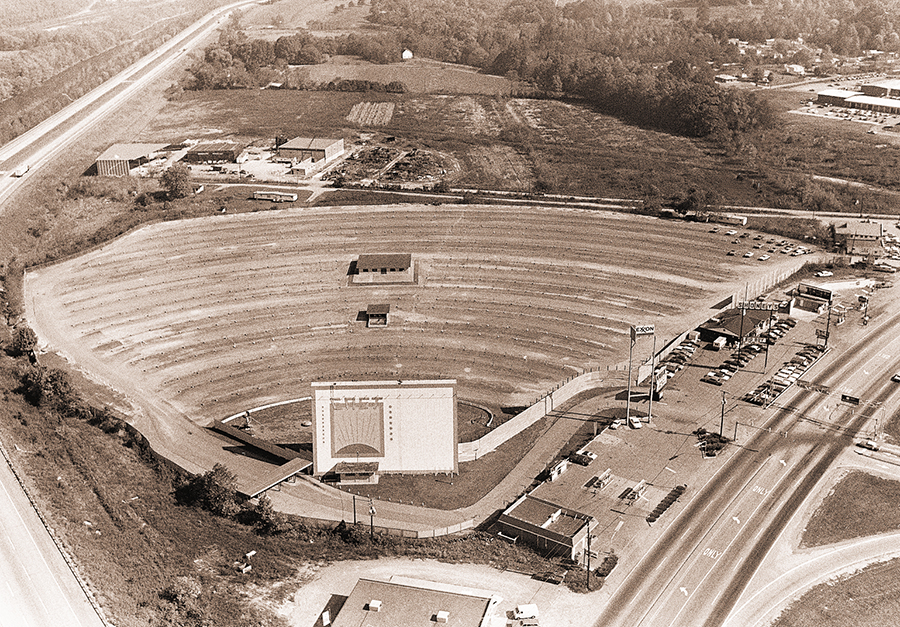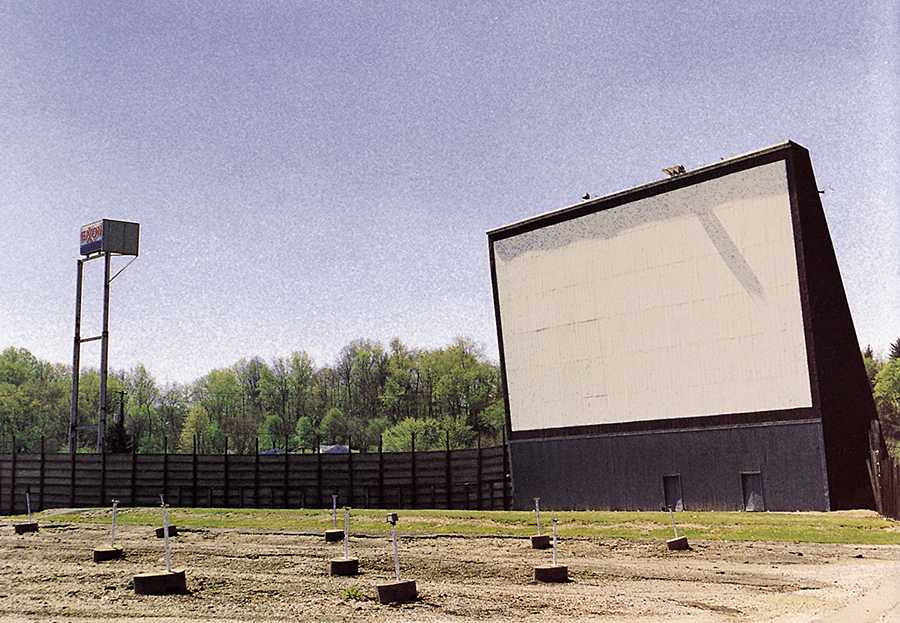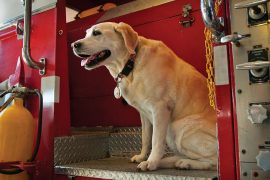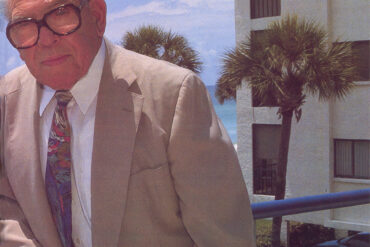By Joseph Platania
HQ 41 | WINTER/SPRING 2001
“That old drive in is a new Wal-Mart.” – lyrics of a country music song.
A generation ago, summer was the season to load up a car, gather friends and family and head out for an evening at the drive-in theater. Names like East, Ceredo, Burlington, Tri-State and Starlite beckoned outdoor moviegoers for decades. Now the drive-in theaters are gone from the Huntington area.
With their flashing marquees announcing the evening’s features, elaborate murals decorating screen towers and the aroma of calorie-packed treats wafting from the concession stand, drive-in theaters have lured millions of moviegoers to enjoy films under the stars.
A unique American institution for more than 60 years, the drive-in is perhaps best remembered as an icon of the 1950s. During this postwar decade, countless families with their baby boomer offspring made the trip to the drive-in a weekly event. For kids, a trip to the drive-in often had a bonus — a mini-amusement park on the grounds below the towering screen.
For teens, the drive-in of the 50s and 60s was an ideal gathering spot where high school kids flocked to show off their hot rods, test out back seat springs and occasionally watch a movie.
The Huntington area had two hot spots: the East Drive-in on U.S. Route 60 near the 29th Street exit of I-64; and the Ceredo Drive-in located just off Route 60 W. on W. 6th Street in Ceredo. Across the Ohio River from Huntington were the Tri-State Drive-in on old Route 52 in Chesapeake, Ohio, the Burlington Drive-in and the Starlite Drive-in located in Burlington, Ohio. There also was a Super 52 Drive-in that was six miles from Huntington in Lawrence County, Ohio.
Between 1946 and 1953, almost 3,000 drive-ins were built in the United States. In 1958, the drive-in movie craze peaked with more than 4,000 screens nationwide. Some theaters had two screens, one facing in one direction and the other facing in the opposite direction.
The Huntington area’s first drive-in theater was the Ceredo, which opened in June 1948. This was followed by the East Drive-in Theater, which opened for business in August 1951.
During the 50s and 60s drive-ins replaced neighborhood theaters, which were closing. In fact, by 1951 patronage of drive-ins was exceeding that of indoor theaters, which declined due to the advent of television.
Because of their reputation as magnets for teenage couples desiring privacy, drive-in theaters were dubbed “passion pits.” Life magazine, in its Winter 1995 issue, states that “in the pre-VCR era, many a teenager got into movies free by climbing into the trunk of a car.”
But during the late 70s and 80s, drive-ins began to close. By the 90s the “passion for the pits” had faded and there were fewer than 900 screens nationwide.
An August 1996 ad for the East Drive-in boasts that the outdoor theater had “the largest screen” as well as a playground, free passes, free train rides, free fire engines rides and hi-fi sound.
The “Burlington Auto Theater” billed itself as “your family theater” and was “five minutes from Huntington.” Its admission price in August 1963 was 75¢ per person, while children got in free.
A noted authority on drive-in theaters has written, “The drive-in was always at a place where the city meets the country…it was right at the edge of town. People from the country would drive in to go to it, and people in the city would drive out to it.”
This description would certainly have applied to the East Drive-in that, for more than 42 years, stood just east of Huntington’s city limits on Route 60. The East was the area’s largest and most popular drive-in theater.
Less than a year after it had opened, The Herald-Advertiser edition for June 15, 1952 had a full-page photo essay about the new theater. The story reports, “The outdoor theater is a phase of living, peculiarly American, and quite popular around Huntington. The baby-sitting problem is eliminated; the ‘don’t annoy your neighbor by talking’ problem is solved and family life is revived in the car at the outdoor theater.”

The article also had photos of a child-sized fire engine that was offered at the East Drive-in Theater as entertainment for children.
More than 40 years later in a September 1992 newspaper article, East Drive-in manager Junior Ross, then a 20-year employee, explained how to spot a non-paying customer trying to sneak into the outdoor theater: “The best tip off is a low-riding car and a lone driver trying to look casual.”
Ross added, “Once we had a car hanging low in back with fingerprints in the dust on the trunk. I followed the driver around until he tried to drive back out the entrance. I said I’d let him leave as soon as he let the kids out of the trunk.”
But the article states, “Unfortunately, the lock had broken and it took the fire department’s emergency tools to pry the trunk open.”
“They were scared to death and as white as sheets,” Ross said. “And all that, and tickets were only $2.50 back then.”
“You can talk to your friends without bothering anyone,” Ross said. “The kids can go out and run around. And you can get two movies for less than the price of one at the other theaters.”
Ross recalled that people used to bring chairs and sit in the back of their trucks. He also remembers people who put blankets on top of their vans and let kids lay on the roof. Owners sometimes would bring their own grills and cook out.
Moviegoers could select their parking spot from among 1000 spaces available and then turn their car radio to 730AM. The radio system had replaced the bulky metal window speakers in 1980.
Eating at the drive-in was always a treat for patrons who would either break out their own snacks or visit the concession booth for candy, popcorn, sodas, pizza, hot dogs or burgers. Ross recalled the East’s heyday “when the popcorn was sold even before it was popped and when every spot on the gravel lot was filled.”
After the sun has set, a drive-in employee would flip a switch to start the film.
Derek Hyman, president of the Greater Huntington Theater Corp., which owned the East, told the newspaper years ago that the drive-in’s demise was a simple matter of economics.
“We face the same problems as many drive-in theaters, Hyman said. “The land underneath is much more valuable than what it’s being used for.”
In 1992, devoted fans were helping to keep the East open. But it was not to be. On November 6, 1993, the outdoor theater was torn down to make way for, you guessed it, a Wal-Mart.
A January 1994 article about the East quotes a former customer who said, “the best theater days were in the 1950s, when families did things together.”
Another East customer recalled, “waiting for the sky to get dark and then loading up the family vehicle to pay one dollar to park and watch movies such as ‘The Prisoner of Zenda.’”
Derek Hyman has a unique perspective on drive-in theaters. His family’s business, the Greater Huntington Theater Corp., has for years owned the downtown theaters and, at one time, also owned and operated four drive-in theaters — the East, Ceredo, Burlington and Starlite.
“The invention of the VCR, the introduction of cable TV, as well as multiple screen movie theaters at malls and elsewhere spelled the end for drive-ins,” says Hyman. He adds that cars got smaller in the 70s and they were less comfortable than the old gas guzzlers for watching movies at a drive-in.
In a book about drive-ins, a report says the middle-to-back rows generally were used by older couples and people who wanted to see the entire movie, while front rows were occupied by young families who used the playground for tots.
The East was the largest drive-in theater in the Tri-State with the biggest screen and the greatest number of parking spaces at 1000. It sold out on weekends, every weekend, during the early to mid 1960s.
Hyman explains that drive-in screens, which were made of galvanized steel or other materials, had to be painted every two or three years.
Since the East closed in 1993, there have been several attempts at reviving the practice of showing movies under the stars. However, Hyman states that it is unlikely that privately owned for profit drive-in movie theaters will ever return to the Tri-State.
Drive-in theaters have been called “one of America’s last great icons. They represent youth, freedom, and a national reverence for the automobile.”
For those who want a quick fix of nostalgia by going to a drive-in theater in West Virginia, moviegoers can still patronize eight of nine drive-ins scattered around the state. The closest to Huntington are the Jungle Drive-in on Rural Route 1 in Parkersburg and the Moonlite Drive-in in Skelton, just north of Beckley.
In southern Ohio the closest are the Kanauga on Route 7 in Gallipolis and the Scioto Breeze on U.S. 23 in Lucasville, just north of Portsmouth.
In eastern Kentucky, you have to motor down to the Judy Drive-in at Mt. Sterling to catch a drive-in movie.
Finally, if you’re looking for someplace closer to experience an outdoor movie, try the Starlight Cinema at the Harris Riverfront amphitheater. Movies are shown on the weekends during the late summer months and, best of all, it’s free.





